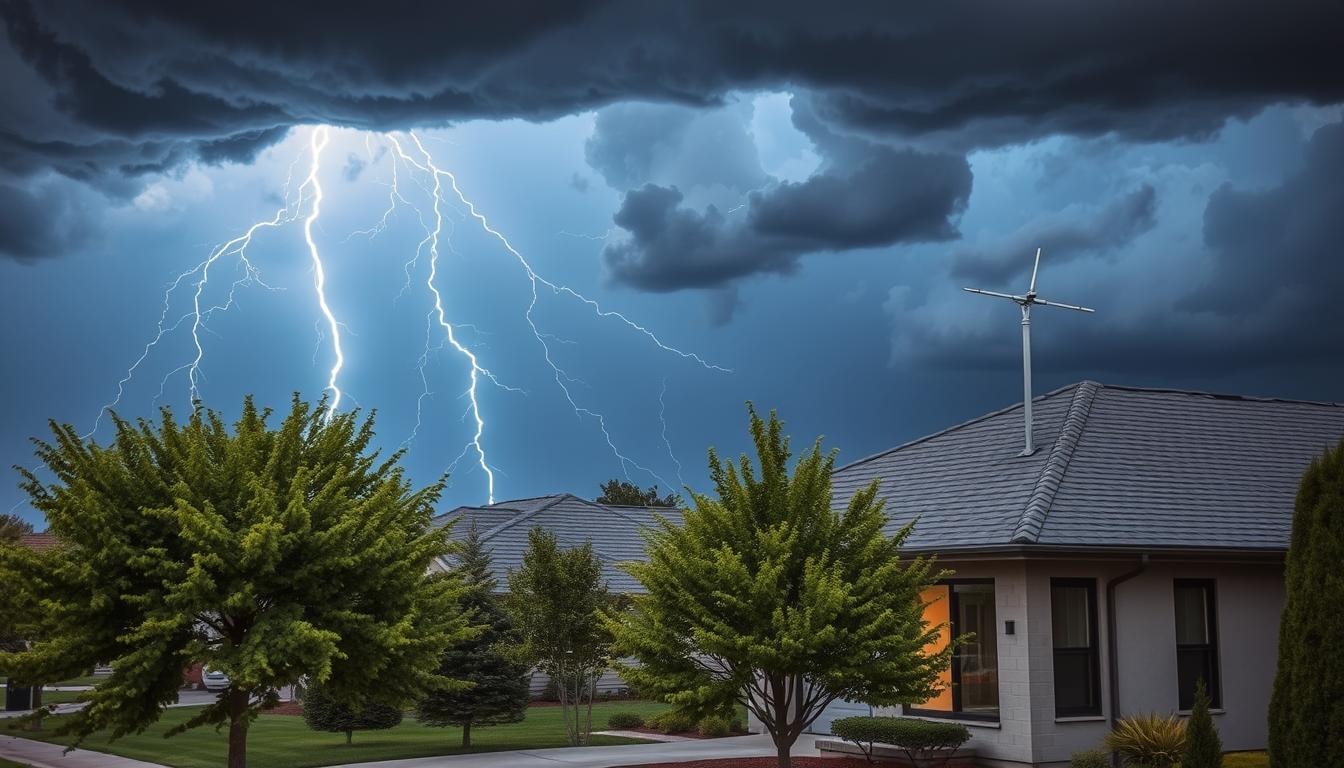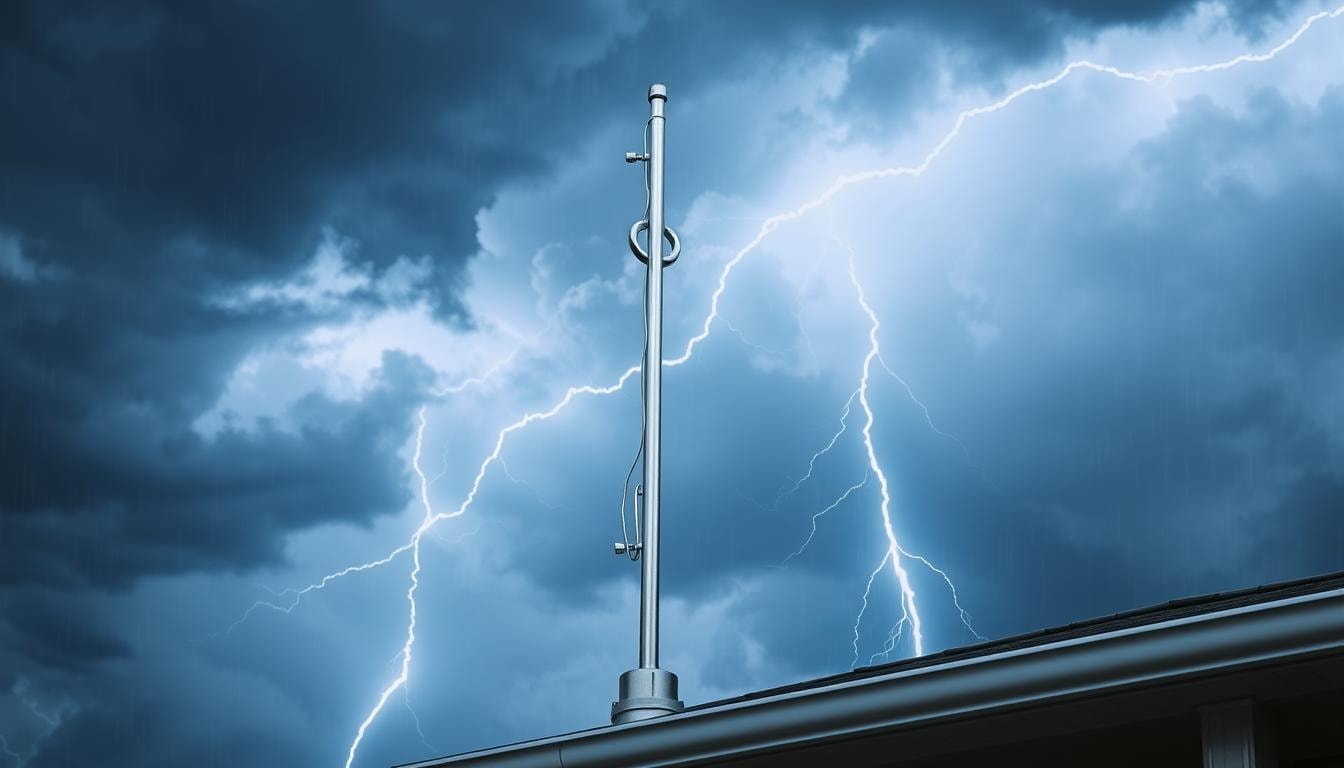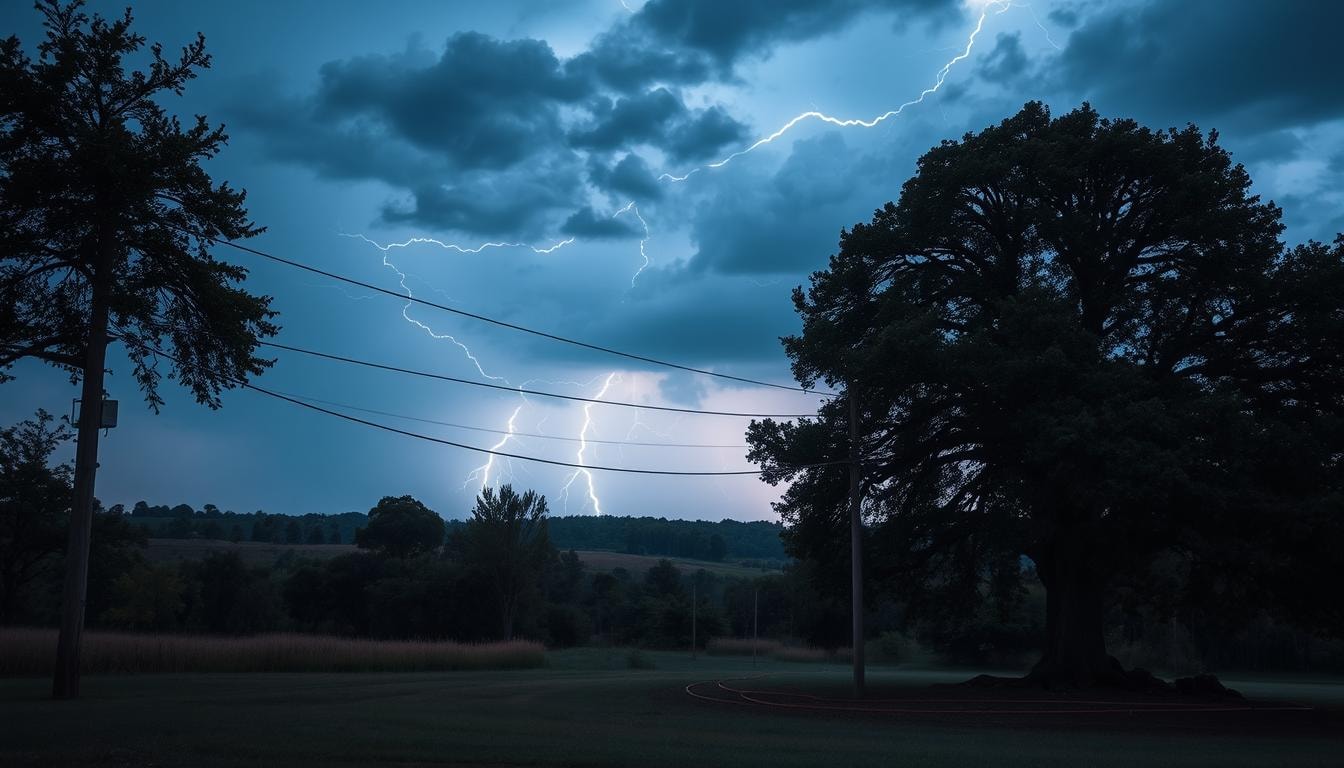Lightning Rod Installers Near You
Can’t find what you are looking for?
How It Works
-
Answer a few questions about your home project.
-
Within seconds, get matched with top-rated local pros.
-
Compare quotes and choose the best pro for the job.
Lightning Rod Installers In Your Area
Lightning Rod Installers: Protect Your Home from Lightning Strikes
Meta Description: Protect your home from lightning strikes with expert Lightning Rod Installers. Get professional installation of lightning protection systems for your peace of mind and property safety.

Lightning strikes cause up to 200,000 home insurance claims yearly in the US. These claims cost nearly one billion dollars in damages. Have you ever considered installing a professional lightning protection system?
Lightning protection systems divert electrical energy from strikes away from your home. They send this energy directly into the ground. Qualified contractors install these systems to meet national safety standards.
This ensures your property is shielded from nature’s powerful displays. Your home and family stay safe from devastating effects.
Key Takeaways
-
01
Lightning strikes result in over 100,000 home insurance claims per year, costing nearly $1 billion in damages
-
02
Lightning protection systems, including lightning rods, can help divert electrical energy from strikes away from your home
-
03
These systems are installed by qualified professionals to meet safety standards and protect your property
-
04
Homeowners in lightning-prone areas or with tall homes should consider investing in a lightning protection system
-
05
A properly installed system creates a safe path for lightning to travel to the ground, bypassing your home and its occupants
The Importance of Lightning Protection
Lightning poses a major threat to people every year. In the U.S., it causes 100,000 to 200,000 home insurance claims annually. These claims cost about one billion dollars each year.
Lightning can damage appliances and electronics silently. It can also start electrical fires, a leading cause of house fires. A good lightning protection system is crucial.
This system should include surge protection devices and a strong grounding system. It helps protect homes and people from lightning strikes and electrical surges.
Frequency of Lightning Strikes and Resulting Damage
The National Severe Storm Laboratory provides data on lightning strikes. For areas with 10-20 storm hours yearly, a house may be hit once in 332 years.
In areas with 100+ storm hours, a strike might occur once in 39 years. Lightning strikes can cause extensive damage to homes.
They can harm electrical components, appliances, and electronics. These strikes may also start fires.
Lightning protection is vital for homes and businesses. It guards against the harmful effects of lightning and electrical surges.
A reliable lightning protection system is a smart investment. It safeguards property, utilities, and valuable electronics from costly and dangerous lightning strikes.
Do You Need a Lightning Rod?
Most homes don’t need a lightning rod. But some situations call for a lightning protection system. These include areas with frequent strikes, tall homes, or houses near tall trees.
A lightning protection system guides high-voltage energy safely to the ground. It includes lightning rods, which are copper rods mounted on structures. These rods offer the easiest path for electricity to dissipate.
- Less than 10% of households have lightning rods installed.
- There are over 22,000 lightning-related fire accidents in a year.
- The Empire State Building gets struck by lightning an average of 100 times a year.
Lightning rods don’t attract or prevent strikes. But they can lower homeowners insurance premiums. Other protection features can also contribute to these savings.
Surge suppressors alone can’t protect against direct lightning strikes. Insurance often won’t cover multiple strikes. A pro-installed system is the best way to protect your home.
Understanding Lightning Rod Installers

Lightning rods protect homes from devastating lightning strikes. These copper rods are placed on buildings to intercept high-voltage electricity. They direct the energy safely to the ground, preventing damage and fires.
What Lightning Rods Do and How They Work
A good lightning protection system needs proper installation of all parts. This includes rods, conductors, grounds, bonds, and surge arresters. Certified installers follow standards set by national safety organizations.
When lightning strikes, the copper rod creates a concentrated electric field. It attracts the discharge and provides a path to the ground. This process is called ionization.
Lightning rods must be installed above the highest point of a building. This ensures the safety of the entire property. Certified installers are key to proper setup of this vital safety equipment.
Components of a Complete Lightning Protection System
A robust lightning protection system safeguards homes and businesses from devastating lightning strikes. It has several key elements working together to divert electrical energy safely to the ground.
The system’s core includes air terminals, also called lightning rods. These metal rods are mounted on the roof as strike receptors. They capture lightning bolts before they can directly impact the structure.
Main conductors connect air terminals to the ground. Made of aluminum or copper, they provide a low-resistance path for electrical current. This allows the energy to flow safely into the earth.
- Grounds, consisting of at least two rods driven at least 10 feet into the soil, act as the final destination for the lightning’s energy, directing it into the ground.
- Bonds join metallic roof components and grounded building systems to the main conductors, ensuring conductivity and preventing dangerous side flashes.
Surge arresters and surge suppressors are installed at the electrical panel. These devices absorb electrical surges, protecting heavy appliances. They also help preserve the integrity of your power systems.
Effective lightning protection systems must be designed and installed by certified installers. They follow standards set by respected organizations. This ensures the system meets safety requirements and provides reliable protection.
Hiring Professional Lightning Rod Installers
Protecting your property from lightning strikes requires expert lightning rod installers. These skilled technicians have the know-how to set up effective lightning protection systems. Their expertise ensures proper installation and compliance with safety standards.
Qualifications and Certifications to Look For
Seek installers listed by Underwriters Laboratories (UL) and certified by the Lightning Protection Institute (LPI). These certifications show they use UL-listed materials and follow national safety standards.
Qualified installers can design and set up complete lightning protection systems. This includes air terminals, conductors, grounds, bonds, and surge protection devices.
Choose contractors who can prove their credentials and experience. This ensures your system is installed correctly and protects your property effectively.
Certified installers provide peace of mind for your property’s protection. They follow strict safety standards in their work. These pros use top-quality materials to install your system to the highest standards.
Protecting Trees from Lightning Strikes

Tall, isolated trees on your land can be at risk of lightning strikes. These strikes can lead to costly damage and endanger nearby structures. The Lightning Protection Institute recommends protecting trees taller than homes or within 10 feet.
Unprotected trees can create a side-flash hazard to nearby homes if struck. A proper tree lightning protection system can safeguard tall trees and prevent damage. This work should be done by qualified and certified lightning protection installers.
A well-designed tree protection system has several key components:
- Air terminals (lightning rods) strategically placed at the highest points of the tree to intercept lightning strikes
- Copper conductors to safely channel the electrical current down the tree and into the grounding system
- Grounding rods that establish a low-resistance connection to the earth, dissipating the lightning’s power
- Surge protectors to regulate the flow of electricity and prevent power surges that could still damage the tree
Installation by experienced certified installers is crucial for system effectiveness. Regular inspections and maintenance ensure the system works during a lightning strike.
Safeguarding your trees with professional lightning protection minimizes damage risk. It keeps your property and loved ones safe from nature’s unpredictable forces.
What to Do During a Lightning Storm
When lightning strikes, seek shelter immediately. An enclosed building or closed-window vehicle is safest. Avoid being the tallest object or near potential conductors like utility poles, trees, and water.
Safety Tips for Lightning Storms
To stay safe during a lightning storm, follow these important tips:
- Avoid using corded phones and steer clear of electrical appliances, TVs, fireplaces, metal objects, windows, and doors, as lightning can travel through these conductive materials.
- If someone is struck by lightning, call emergency services immediately and provide first aid if qualified. Lightning victims are safe to touch and require immediate medical attention.
- For more information on lightning safety, consult the Lightning Protection Institute or Underwriter Laboratories.
These precautions can protect you from lightning dangers. Seek shelter when you hear thunder or see lightning.
Remember, lightning can strike up to 10 miles away from rain. Stay alert and prioritize safety during storms.
Whole-House Surge Protection
Protecting your home’s electronics goes beyond installing lightning protection. Electrical surges can happen for many reasons. They can travel through power, phone, and cable lines, damaging unprotected devices over time.
Properly installed Surge Protection Devices (SPDs) help divert surges to the ground. They work with a reliable grounding system to protect valuable equipment. Ask a qualified electrician to check your home’s grounding and install whole-house surge protection.
Protecting Your Electronics and Appliances
Electrical surges threaten your appliances and electronics. Experts say surge suppression is key to safeguarding these investments. Unprotected devices may fail or wear out faster due to surges.
- Surge Protection Devices (SPDs) divert excess electrical pressure away from sensitive electronics, using components like gas discharge arrestors and metal oxide varistors.
- Whole-home surge protection systems are available to shield a property from lightning strikes, with installation options between the meter and power lines or between the meter and the electrical panel.
- Surge protection is only effective if the home is properly grounded, ensuring a safe path for excess electricity to be diverted.
Experts suggest a multilevel surge protection plan. This includes lightning rods, whole-home units, and individual surge protectors. Uninterruptable Power Supplies (UPS) connected to outlets also help.
This approach protects your air conditioning, furnace, refrigerator, and other valuable devices. It keeps your home safe from electrical surges and lightning strikes.
During severe storms, unplug devices and surge protectors for extra safety. Underwriters Laboratories recommends this precaution. Prioritize whole-house surge protection to safeguard your investments and prevent costly damage.
FindPros: Get the Best Lightning Protection Experts
Don’t leave your home’s safety up to chance. With FindPros, you can easily connect with top-rated lightning rod installation professionals in your local area. Simply answer a few quick questions about your project needs, and our service will match you with pre-screened experts who can provide free estimates.
This ensures you get the right equipment and installation that meets safety standards, protecting your property from the damaging effects of lightning strikes. FindPros makes it easy to compare quotes and find the contractor that best fits your budget and preferences, so you can have peace of mind and a lightning rod system that keeps your home safe.
Conclusion
Installing a complete lightning protection system is vital for safeguarding homes from lightning strikes. This includes lightning rods and whole-house surge protection. Lightning is a common weather hazard that can cause major home insurance claims.
Homeowners in lightning-prone areas should invest in professional protection systems. This is especially true for those with tall homes or nearby trees. Qualified contractors should install these systems following industry standards.
A lightning protection system guards against fire and structural damage. It also prevents issues like system disruptions and costly repairs. With more frequent lightning strikes, this investment is wise for homeowners.
Proactive measures are key as lightning strikes become more common. By prioritizing safety, homeowners can reduce risks and insurance claims. This ensures the long-term protection of their homes and families.
Frequently Asked Questions (Lightning Rod Installers)
MOST POPULAR CITIES
Browse by State- Alameda
- Costa Mesa
- Laguna Beach
- Orange
- Alhambra
- Culver City
- Lancaster
- Oroville
- Anaheim
- Daly City
- Livermore
- Oxnard
- Antioch
- Davis
- Lodi
- Pacific Grove
- Arcadia
- Downey
- Lompoc
- Palm Springs
- Bakersfield
- El Centro
- Long Beach
- Palmdale
- Barstow
- El Cerrito
- Los Angeles
- Palo Alto
- Belmont
- El Monte
- Malibu
- Pasadena
- Berkeley
- Escondido
- Martinez
- Petaluma
- Beverly Hills
- Eureka
- Marysville
- Pomona
- Brea
- Fairfield
- Menlo Park
- Port Hueneme
- Buena Park
- Fontana
- Merced
- Rancho Cucamonga
- Burbank
- Fremont
- Modesto
- Red Bluff
- Calexico
- Fresno
- Monterey
- Redding
- Calistoga
- Fullerton
- Mountain View
- Redlands
- Carlsbad
- Garden Grove
- Napa
- Redondo Beach
- Carmel
- Glendale
- Needles
- Redwood City
- Chico
- Hayward
- Newport Beach
- Richmond
- Chula Vista
- Hollywood
- Norwalk
- Riverside
- Claremont
- Huntington Beach
- Novato
- Roseville
- Compton
- Indio
- Oakland
- Sacramento
- Concord
- Inglewood
- Oceanside
- Salinas
- Corona
- Irvine
- Ojai
- San Bernardino
- Coronado
- La Habra
- Ontario
- San Clemente